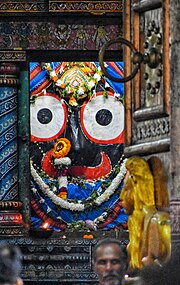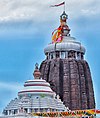Sangita Narayana
| Oṛiśī Sangīta |
| Odissi music |
|---|
 |
| Composers |
| Shāstras |
| Compositions |
| Instruments |
TheSangita Narayana(IAST:'Sangīta Nārāyana') is a 17th-century musical treatise belonging to the tradition ofOdissi music(a genre of classical music in India), written by musicianKabiratnaPurusottama Misra[1]and attributed to GajapatiSarbagyaJagannatha Narayana DevaofParalakhemundi.[2]It is one of the most important musical treatises discovered from Odisha and is one of the fundamental texts followed inOdissi musictill date.[3][4]The treatise was first published by theOdisha Sangeet Natak Akademiin 1966,[5]followed by a critical edition published by theIndira Gandhi National Centre for the Artsin 2009.[1]Manuscripts of the work are found across India, indicating its national circulation.[1]In 1987, Jonathan Katz in his D. Phil. thesis extensively analysed the musicological portions of the Sangitanarayana.[1]
Author
[edit]Purusottama Misra hailed from a family of musicians and litterateurs. He is known to have composed another musical treatise by the name ofTalasangraha,which is unavailable.[6]In theSangita Narayana,several older treatises are cited, includingVishnu Purana,Narada Samhita,Shiva Samhita,Parshurama Samhita,Brihaddeshi,Kohaliyam,Sangita Ratnakara,Panchamasara Samhita, Sangita Ratnamala, Sangita Damodara,Sangita Kaumudi,Gita Prakasaamong others.[6]The work is dated to 1646-50 AD by Dr. Mamata Mishra based on comparative study with the work of the Narayana Misra'sSangita Sarani,Narayana being the son of Purusottama.[7]Prof. Mandakranta Bose too dates it to the 17th century.[1]
The patron of the work Gajapati Jagannatha Narayana Deva was the erstwhile ruler of Paralakhemundi, one of the largest and most powerful kingdoms in ancient Odisha. The king identifies himself as a disciple ofKabiratnaPurusottama Misra in a graceful tribute to his Guru.[6]
Contents
[edit]The text deals with the conventional trio ofgita, vadya, nrtyathat formsangitaand it does so in exemplary detail.[6]The example songs given to illustrate points are mostly dedicated to Gajapati Narayana Deva.[1]Like most Odia authors, Misra begins his treatise with a customary invocation toJagannatha,the venerable deity of Odisha.[1]
He cites certain musicologists preceding him, likeHarinayaka,author ofSangitasaraand Krusnadasa Badajena Mahapatra, author ofGita Prakasa.[3]
The ragas described in the Sangita Narayana areSri, Natta, Karnāta, Rebagupta, Basanta, Bhairaba, Bangāla, Soma, Āmrapanchama, Kāmoda, Megha, Drābidagouda, Turaska Gouda, Barādi, Drabida Barādi, Desi Barādi, Suddha Barādi, Gujjari, Sourastra Gujjari, Dakhina Gujjari, Todi, Mālabasri, Saindhabi, Debakiri, Rāmakiri, Prathama Manjari, Nattā, Belābali, Goudi, Gouda, Nāta, Ghantāraba, Nata Nārāyana, Bhupati, Sankarābharana, Madhyamādi, Mallāra, Desapāla, Mālaba, Andolita (Hindola), Nagadhwani, Gundakiri, Khambhābati, Madhyamādi, Mallāra, Desapāla, Mālaba, Megharanji, Manju Kalyānikā, Chhāyātodi, Pratāpabelābali, Pourabi, Nattamallārika, Ballabi, Gouri, Saranga, ĀsābariandMukhābari.[8]Most of these ragas continue to be popular in present-dayOdissi musicrepertoires.[4]
References
[edit]- ^abcdefgMisra, Purusottama (2009). Bose, Prof. Mandakranta (ed.).Sangitanarayana (A Seventeenth Century Text on Music and Dance from Orissa).Indira Gandhi National Centre for the Arts and Motilal Banarsidass Publishers Pvt. Ltd.ISBN9788120832886.
- ^Kavi, M. Ramakrishna (1999).Bharatakosa (A Dictionary to Technical Terms with definitions on Music and Dance Collected from the Works of Bharata and Others).Munshiram Manoharlal.ASINB00GS1O0H4.
- ^abBadajena Mahapatra, Krusnadasa(1983). Panigrahi, Nilamadhab (ed.).Geeta Prakash.Bhubaneswar: Odisha Sangeet Natak Akademi.
- ^abPanda, Pt. Gopal Chandra(2004).Odisi Raga Ratnabaliओडिसी राग रत्नावली(in Hindi). Bhubaneswar.OCLC225908458.
{{cite book}}:CS1 maint: location missing publisher (link) - ^Deva, Gajapati Narayana (1966). Acharya, Pt. Banambara;Patnaik, Kabichandra Dr. Kali Charan;Mohapatra, Kedarnath(eds.).Sangita Narayana.Bhubaneswar: Odisha Sangeet Natak Akademi.
- ^abcdParhi, Dr. Kirtan Narayan(2017).The Classicality of Orissi Music.India: Maxcurious Publications Pvt. Ltd. p. 383.ISBN9788193215128.
- ^Misra, Kabiratna Narayana. Mishra, Dr. Mamata (ed.).Sangita Sarani.Bhubaneswar: Odisha Sangeet Natak Akademi.
- ^Parhi, Kirtan Narayan(2009). "Odissi Music: Retrospect and Prospect". In Mohapatra, PK (ed.).Perspectives on Orissa.New Delhi: Centre for study in civilizations. pp. 613–626.

